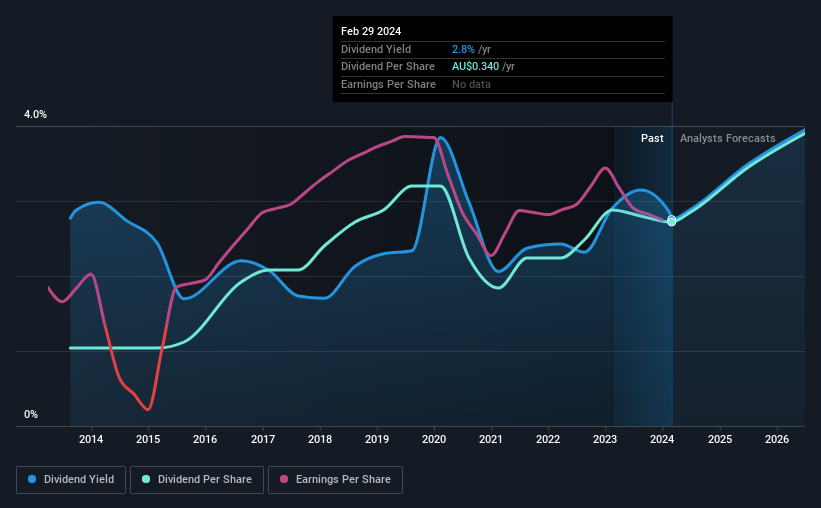It Might Not Be A Great Idea To Buy Treasury Wine Estates Limited (ASX:TWE) For Its Next Dividend
Regular readers will know that we love our dividends at Simply Wall St, which is why it's exciting to see Treasury Wine Estates Limited (ASX:TWE) is about to trade ex-dividend in the next four days. The ex-dividend date is usually set to be one business day before the record date which is the cut-off date on which you must be present on the company's books as a shareholder in order to receive the dividend. It is important to be aware of the ex-dividend date because any trade on the stock needs to have been settled on or before the record date. Thus, you can purchase Treasury Wine Estates' shares before the 6th of March in order to receive the dividend, which the company will pay on the 3rd of April.
The company's next dividend payment will be AU$0.17 per share, and in the last 12 months, the company paid a total of AU$0.34 per share. Looking at the last 12 months of distributions, Treasury Wine Estates has a trailing yield of approximately 2.8% on its current stock price of AU$12.35. Dividends are a major contributor to investment returns for long term holders, but only if the dividend continues to be paid. That's why we should always check whether the dividend payments appear sustainable, and if the company is growing.
See our latest analysis for Treasury Wine Estates
If a company pays out more in dividends than it earned, then the dividend might become unsustainable - hardly an ideal situation. Last year, Treasury Wine Estates paid out 107% of its income as dividends, which is above a level that we're comfortable with, especially if the company needs to reinvest in its business. Yet cash flow is typically more important than profit for assessing dividend sustainability, so we should always check if the company generated enough cash to afford its dividend. It paid out an unsustainably high 204% of its free cash flow as dividends over the past 12 months, which is worrying. Unless there were something in the business we're not grasping, this could signal a risk that the dividend may have to be cut in the future.
Cash is slightly more important than profit from a dividend perspective, but given Treasury Wine Estates's payouts were not well covered by either earnings or cash flow, we would be concerned about the sustainability of this dividend.
Click here to see the company's payout ratio, plus analyst estimates of its future dividends.
Have Earnings And Dividends Been Growing?
Companies with falling earnings are riskier for dividend shareholders. If business enters a downturn and the dividend is cut, the company could see its value fall precipitously. Treasury Wine Estates's earnings per share have fallen at approximately 10% a year over the previous five years. Such a sharp decline casts doubt on the future sustainability of the dividend.
Treasury Wine Estates also issued more than 5% of its market cap in new stock during the past year, which we feel is likely to hurt its dividend prospects in the long run. It's hard to grow dividends per share when a company keeps creating new shares.
The main way most investors will assess a company's dividend prospects is by checking the historical rate of dividend growth. In the past 10 years, Treasury Wine Estates has increased its dividend at approximately 10% a year on average. The only way to pay higher dividends when earnings are shrinking is either to pay out a larger percentage of profits, spend cash from the balance sheet, or borrow the money. Treasury Wine Estates is already paying out 107% of its profits, and with shrinking earnings we think it's unlikely that this dividend will grow quickly in the future.
Final Takeaway
Has Treasury Wine Estates got what it takes to maintain its dividend payments? Not only are earnings per share declining, but Treasury Wine Estates is paying out an uncomfortably high percentage of both its earnings and cashflow to shareholders as dividends. This is a clearly suboptimal combination that usually suggests the dividend is at risk of being cut. If not now, then perhaps in the future. With the way things are shaping up from a dividend perspective, we'd be inclined to steer clear of Treasury Wine Estates.
So if you're still interested in Treasury Wine Estates despite it's poor dividend qualities, you should be well informed on some of the risks facing this stock. Every company has risks, and we've spotted 4 warning signs for Treasury Wine Estates (of which 1 makes us a bit uncomfortable!) you should know about.
If you're in the market for strong dividend payers, we recommend checking our selection of top dividend stocks.
Have feedback on this article? Concerned about the content? Get in touch with us directly. Alternatively, email editorial-team (at) simplywallst.com.
This article by Simply Wall St is general in nature. We provide commentary based on historical data and analyst forecasts only using an unbiased methodology and our articles are not intended to be financial advice. It does not constitute a recommendation to buy or sell any stock, and does not take account of your objectives, or your financial situation. We aim to bring you long-term focused analysis driven by fundamental data. Note that our analysis may not factor in the latest price-sensitive company announcements or qualitative material. Simply Wall St has no position in any stocks mentioned.

